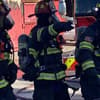Podcast
Questions and Answers
Who is authorized to modify the assignment for an Air Rescue assignment?
Who is authorized to modify the assignment for an Air Rescue assignment?
- Engine company personnel
- Rescue unit personnel
- Uniformed Fire Department Officers (correct)
- Dispatchers
What may create the need for additional units during a heli-spot assignment?
What may create the need for additional units during a heli-spot assignment?
- Dispatcher's suggestion
- Modification of assignments
- Securing the HS site (correct)
- Incident circumstances
When should additional units be dispatched for an Air Rescue assignment?
When should additional units be dispatched for an Air Rescue assignment?
- When dictated by incident circumstances (correct)
- When requested by dispatchers
- Immediately after dispatch
- Always
Which type of patient would NOT necessitate an Air Rescue response according to the text?
Which type of patient would NOT necessitate an Air Rescue response according to the text?
What is a primary factor that determines the need for Air Rescue response?
What is a primary factor that determines the need for Air Rescue response?
Which situation would NOT warrant Air Rescue response based on the text?
Which situation would NOT warrant Air Rescue response based on the text?
What is the procedure for ground personnel after loading the patient onto the helicopter?
What is the procedure for ground personnel after loading the patient onto the helicopter?
What is the protocol for hospital staff upon the helicopter's arrival at the designated receiving hospital's helipad?
What is the protocol for hospital staff upon the helicopter's arrival at the designated receiving hospital's helipad?
Under what circumstances might a fire department be involved in an inter-facility patient transfer?
Under what circumstances might a fire department be involved in an inter-facility patient transfer?
What role does the fire agency play in an inter-facility patient transfer according to Section F under Transport Guidelines?
What role does the fire agency play in an inter-facility patient transfer according to Section F under Transport Guidelines?
In what situation might flight medics of an aircraft require assistance in commuting from the Landing Zone to a transferring hospital?
In what situation might flight medics of an aircraft require assistance in commuting from the Landing Zone to a transferring hospital?
What is a crucial safety consideration to take into account when requesting Air Rescue for patient transport?
What is a crucial safety consideration to take into account when requesting Air Rescue for patient transport?
What condition would prevent a helicopter from flying during Air Rescue operations?
What condition would prevent a helicopter from flying during Air Rescue operations?
In which scenario should on-scene personnel secure a MedCom channel and provide an initial telemetry report to the receiving facility?
In which scenario should on-scene personnel secure a MedCom channel and provide an initial telemetry report to the receiving facility?
What is a requirement for every landing zone used during Air Rescue operations?
What is a requirement for every landing zone used during Air Rescue operations?
What action should ground crews take if they identify a hazard during the helicopter's final approach to the landing zone?
What action should ground crews take if they identify a hazard during the helicopter's final approach to the landing zone?
Why should personnel remove all sheets and blankets from the patient and stretcher prior to approaching the helicopter for loading?
Why should personnel remove all sheets and blankets from the patient and stretcher prior to approaching the helicopter for loading?
During patient preparation for transport via Air Rescue, what should personnel ensure regarding the patient's feet and lower legs?
During patient preparation for transport via Air Rescue, what should personnel ensure regarding the patient's feet and lower legs?
'Abort.Abort.Abort' should be announced over the radio by ground crews if:
'Abort.Abort.Abort' should be announced over the radio by ground crews if:
What is the purpose of having a designated marshaller present at all times during helicopter landing, patient loading, and take off?
What is the purpose of having a designated marshaller present at all times during helicopter landing, patient loading, and take off?
What role does the Incident Commander play in Air Rescue operations involving helicopters?
What role does the Incident Commander play in Air Rescue operations involving helicopters?
Flashcards are hidden until you start studying
Study Notes
- Standard Air Rescue dispatch includes one engine company and one rescue. Additional units required should depend on incident circumstances.
- Dispatchers should not modify or suggest modifications to the assignment, only Uniformed Fire Department Officers can do so.
- Air Rescue response may be necessary for various reasons including: level 1 or 2 trauma patients with long ground transport times, inaccessible patient locations, extrication needs, cardiac or pulmonary crises, drowning, inter-facility transfers, and search and rescue.
- Weather conditions, power lines, trees, debris, pedestrian and vehicular traffic, and dusty/dry landing zones are safety considerations for Air Rescue transport.
- If Air Rescue is utilized for transport, a tactical channel must be assigned for communications and on-scene personnel must provide patient status, weight, airway compromise, combative/suicidal patients, and a secure landing zone.
- Landing zones should be clear of potential hazards and have a designated marshaller present during helicopter landing, patient loading, and take off.
- Patient preparation involves securing the patient to a long spine board and informing them about the helicopter's noise, heat, and wind levels. Personnel must keep clear of the helicopter until flight medics brief them on the patient's status.
- Prior to approaching the helicopter, personnel must remove all sheets, blankets, and IV poles to prevent them from becoming airborne hazards. A minimum of three personnel will move the patient to the helicopter, with the flight medic at the patient's left foot.
- Ground personnel must leave the landing zone area together following a standard route upon the helicopter's arrival at the hospital. Hospital staff must remain clear of the landing area until directed to approach by the flight crew.
- Inter-facility patient transfers may require assistance from the fire agency to establish a landing zone and help flight medics commute to the transferring hospital.
Studying That Suits You
Use AI to generate personalized quizzes and flashcards to suit your learning preferences.





